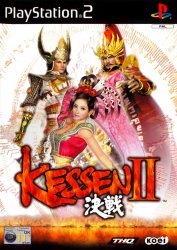

Liu Bei - Leader of the Shu forces and Lord of Xu.The majority of characters are loosely based on characters found in the Chinese epic Romance of the Three Kingdoms. In battle, these characters are able to cause earthquakes, summon lightning storms and hurl fireballs. Koei introduces elements of magic, especially with the portrayal of notable strategists such as Zhuge Liang and Sima Yi as sorcerers. In addition to the fantasized theme, Kessen II departs from its realistic predecessor. A significant change to the story involves a romance between Liu Bei and the character Diao Chan, being a significant factor behind Liu Bei's decision to go to war, and Himiko, a semi-fictional sorceress (the historical Himiko ruled Wa ). The last of the Han dynasty family, Liu Bei, begins a rebellion against the kingdom of Wei led by Cao Cao, with much of the game's events being based on the novel with alterations due to the different storylines. Unlike Koei's other games based on the 14th century novel Romance of the Three Kingdoms ( Dynasty Warriors and the Romance of the Three Kingdoms game), the plot of Kessen II is a heavily fantasized version of the novel. While in control of a unit, players are able to use special skills or magic spells to turn the tables, although enemy characters are also able to do so. All units are controlled by the AI unless the player directly intervenes, and battles between forces are carried out in real-time. Before battle, players are given a choice of strategies to take, although they can manually control all units in the battlefield. The gameplay involves playing out major battles as the storyline progresses, with cutscenes between each battle for the development of the events and major characters. It is the sequel to Kessen in name only both Kessen and the later sequel Kessen III are based on events in Japan and China. The demonstration of the ability of HLA-DR − melanoma cells to express HLA-DR after IFN-γ treatment was extended to cells from other types of tumor such as gliomas, colon carcinomas and one cervical carcinoma cell line.Kessen II ( 決戦 II, Kessen Tsu) is a strategy game loosely based on the Three Kingdoms period of China. Eight days after removal of IFN, the HLA-DR level was reduced by more than 90% and the level of HLA-ABC and β 2-microglobulin by more than 50%. When IFN-γ-treated cells were cultured without IFN the induced or enhanced expression of HLA antigens was reversible. Immunoprecipitation experiments using detergent-solubilized 125I-labeled membrane proteins of IFN-γ-treated melanoma cells and a monoclonal anti-HLA-DR antibody confirmed the presence of HLA-DR antigens. Analyses of IFN-γ-treated cells by flow micro-fluorometry showed a homogeneous distribution of increased staining intensity rather than the appearance of two cell populations. A dose of 20 U/ml IFN-γ started to induce the expression of HLA-DR and DC on melanoma cells GLL-19 and Me-43 and a plateau of maximum antigen expression was reached with 100 U/ml. A minimum incubation time of 48 h was necessary for the appearance of HLA-DR on the two HLA-DR − melanoma lines, whereas HLA-ABC and β 2-microglobulin were already increased after 24 h. The modulation of antigens by IFN-γ was both dose and time dependent. The expression of 3 out of 6 melanoma-associated differentiation antigens was enhanced by IFN-γ treatment. In contrast, IFN-α gave no induction of expression of HLA-DR and DC on two DR − melanoma lines, while it did enhance the expression of HLA-ABC and of β 2-microglobulin. IFN-γ also enhanced the expression of HLA-ABC and β 2-microglobulin, as well as HLA-DR on DR + melanoma cells. In addition, IFN-γ induced the expression of another class II antigen, HLA-DC, on a HLA-DR + and -DC − melanoma cell line and to a lower level on a -DR and -DC − melanoma line.



Recombinant interferon-γ (IFN-γ) induced the expression of HLA-DR when added to the culture medium of HLA-DR − melanoma cell lines.


 0 kommentar(er)
0 kommentar(er)
